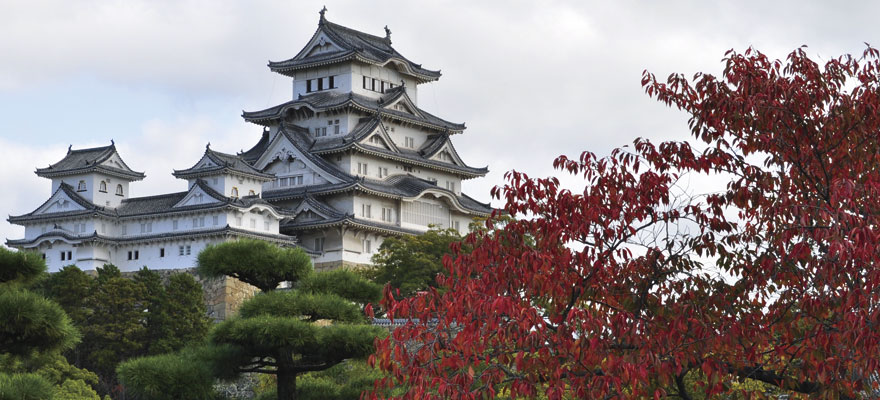Home > Highlighting JAPAN > Highlighting Japan October 2013 >Japanese Globalization
Highlighting JAPAN
47 Prefectures from A to Y
Hyogo
Connection to an Ancient Past

THE city of Himeji in Hyogo Prefecture is full of relics from Japan's glorious past. Kanbei Kuroda, the main character in next year's Taiga Drama, is a figure associated with Himeji. I visited traces left by Kanbei Kuroda and his ancestors. Indeed, only 800 meters out from Himeji Station sits one of Japan's most celebrated historical icons, the World Heritage listed Himeji Castle.
The castle complex, as it is now, was built in 1609 by Lord Ikeda Terumasa and has been preserved through careful restoration. Right now, the castle is undergoing its Heisei period restoration with the aim of repairing the main keep's white plaster wall and roof tiles.
The imposing structure of the castle's main tower, as a result, is under scaffolding cover. Its lesser cousins though, the east, west and northwest small keeps are still open for viewing. So too is the west bailey, an addition to the castle's defensive measures in 1618, which doubled as the nagatsubone, the female living quarters.
One of the most distinctive features of the castle is the lustrous whiteness of its walls, earning it the endearing name Hakuro-jo (White Heron Castle). Using a traditional Tosa and Nanban mix of slaked lime, shell ash, hemp fibre and dulse iridea (a form of seaweed), the white plaster covers the castle's exterior with the exception of narrow openings in the walls that once served as weapons portals.
The castle's white tiers rest on top of a base of stones that resemble open ogi folding fans, in some cases looming as high as 30 meters. Turrets, iron-plated gates and moats complete the castle's formidable defences, and are still in their original state.
The restorations are due to finish in 2014 but in the meantime, the castle's administration has installed a lift for the purpose of viewing the scene of restoration work. It sits just meters from the main keep's exterior wall, which stops at the castle's top-tier level and the main roof, and offers panoramic views of Himeji City and close-up views of the main keep's exterior.
A half-an-hour bus ride north-west from the castle is Mt. Shosha. At the top of the mountain, the forest shadows cast a solemn silence on moss-covered roots and a line of Kannon Bodhisattvas statues that lead to the mountain's most ubiquitous feature — the Buddhist temple complex Engyoji.
Founded in 966, the temple was an important training center for priests in the western area of the Kansai district and became a site for Buddhist pilgrimage. A 40-minute loop starts at the Bell of Benevolence, a large bronze bell that is rung for world peace, and arrives at the main temple, Maniden, which was constructed in 970 but was rebuilt in 1930 after being burned down.
Inside Maniden, candle light casts flickering shadows across the deep brown of the temple's wooden interior, and pilgrims dressed in white, chant in unison. Next to the temple's bell hangs an ornate bronze lamp tinged from the stream of smoke that rises from the incense pot that sits beneath it.
At Juryo-in, a sub-temple immersed in the tranquil silence of the woods, visitors can have some shojin ryori, local vegetarian cuisine served in traditional Engyoji red lacquerware.
Himeji's other historical sites, such as the Nishioyashikiato Garden Kokoen, where visitors can participate in a tea ceremony, and Himeji's museums, add to the city's immersive quality. Every fall, they hold Nada no Kenka Matsuri, or the "Fighting Festival," a soul-stirring Shinto ritual in which mikoshi (portable shrines) are smashed together amidst rousing shouts and taiko drums. The festival, with a history and tradition conveying enthusiastic passion to the present day, attracts over 100,000 ecstatic visitors every year. Irrevocably tied to the country's epic ancient past, the city is a portal into another time and a wonderful escape from the white noise of city life.
© 2009 Cabinet Office, Government of Japan






